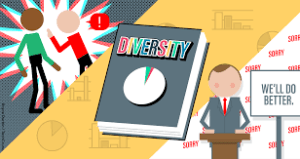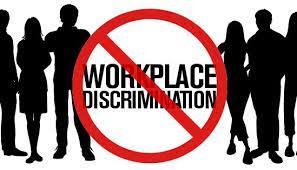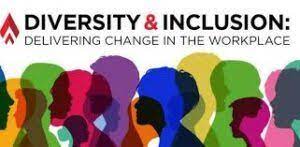Introduction
Let me first make this absolutely clear: Cultural Diversity at the workplace has proven to be good for any organization. I have already dedicated an article to  the benefits of cultural diversity at the workplace, which can be accessed here.
the benefits of cultural diversity at the workplace, which can be accessed here.
To name one positive aspect, it increases creativity. To name another: you will view a problem from different perspectives. Many organizations pretend to have inclusive leaderships to achieve this, but how can we really know?
Anyway, there is another side of the coin, research shows that diversity can also lead to more conflict and dissatisfaction. Here I am going to explain how to handle problems with cultural diversity in the workplace.
And if you are not interested in the corporate jungle, I have a proposition for you in the end.
Cultural diversity and inclusion
 You should always start with the question: what do you mean by diversity and inclusivity of leadership? People often think of other cultures, gender, LGBTI people, age and people with disabilities.
You should always start with the question: what do you mean by diversity and inclusivity of leadership? People often think of other cultures, gender, LGBTI people, age and people with disabilities.
But diversity is about all people and the question of how a team can be supplemented as well as possible to perform better. So you don’t strive for diversity to score (this is what I meant with so-called pretentious companies in the first paragraph), but because you want to improve the DNA of a company.
Inclusive leadership
How do you ensure that all employees believe in the added value of a mixed group and dare to step out of their bubble? As always, change starts at the top. You can forget it without the involvement of the company’s top management. They should speak out about the importance of diversity.
The middle managers are also an essential link. They will have to implement the policy, while they often live for the issues of the day and are judged on the actual performance of their team. A manager is used to acting quickly and therefore relying on what has always worked. But inclusive leadership goes beyond ticking off boxes. They must create a respectful environment in which everyone can be at their best.
Increased creativity
An often-mentioned argument is that diversity increases creativity at work. But research also shows that groups consisting of different people are  sometimes less well-integrated and more dissatisfied. Diversity can make communication more difficult, which means tasks are performed less well, there is more conflict between employees and they are even absent more often or leave the company earlier.
sometimes less well-integrated and more dissatisfied. Diversity can make communication more difficult, which means tasks are performed less well, there is more conflict between employees and they are even absent more often or leave the company earlier.
People often find it difficult to work with colleagues who are different from them. They cannot read the other person and suddenly have to think about all kinds of small things that distract from the main task. They, therefore, believe that managers should also recognize and discuss the difficult sides of diversity.
Strong role models
Some people regularly speak out about this. They think that some companies mainly want to color in a “United Colors of Benetton image”. They are so blindly fixed at decency and other labels that it “does not call for people to look closely.” They also criticize the emergence of diversity managers.
This threatens to reduce people to their gender or ethnicity to become a tough revenue model. They are also against women’s quotas in business. That confirms the image that women are gray mice who only progress with the help of the law. That way they never become a strong role model and women only have Margaret Thatcher to look up to.
How to become a Margaret Thatcher
They believe that change cannot be enforced by the top, but should come from below. That’s why some people think to start training which helps young women between the ages of 15 and 25 to become more assertive. They often have not learned to represent their ambition. Bring together women from different backgrounds, all of whom have suffered in some way, for example, because they have been bullied, fled or lost someone. Teach them that they should not be ashamed, that they can combine work and children and even become prime ministers.
Feel safe
 But only training does not remove the barriers applicants often experience. Someone can be assertive, and the top of the company they are applying for can be inclusive on paper, but will you be judged on the right qualities, or will you be pigeonholed?
But only training does not remove the barriers applicants often experience. Someone can be assertive, and the top of the company they are applying for can be inclusive on paper, but will you be judged on the right qualities, or will you be pigeonholed?
Managers often say: I’m just looking for someone who is good. But on which competencies do you select – and is there a bias in those competencies? They hope that they will make women strong enough to overcome those obstacles. They also teach that they have to work with men, instead of working against them, so they reach out and pull you up that monkey rock. Some feminists hate this but use your charm. You are not one of the guys, so position yourself differently.
When the work begins
When a diverse team is put together, the work only begins. You will need to keep talking about the differences in ideas and approaches. Inclusive leadership also means that everyone feels safe and can make their voice heard. A recently interviewed editor said: I would like a diverse team, but I think the quality is more important.
Colleagues then fell over it, while it is good to discuss matters like this. Some psychologists say that ” stiff processes “can lead to a better outcome. That’s because the presence of” strangers “forces a group to more carefully investigate tacit assumptions. So anyone who sincerely invests in diversity in a company usually gets a lot in return. And no trophy can match that.
Three general matters that will always help
1. Be open and ask neutral questions
Ask as many open and “neutral” questions as possible during the introduction or intake, especially on matters such as religion, culture, relationships and  identity. Do not assume that you can immediately see or notice that someone has difficulty reading and writing, or is gay or lesbian.
identity. Do not assume that you can immediately see or notice that someone has difficulty reading and writing, or is gay or lesbian.
Introduce questions about the past, culture and philosophy of life carefully. For example: “In order to help you well, I would like to get to know you a little better. That is why I am going to ask you some questions. So that I understand what your concerns are and how I can help you. “
2. Inform yourself
You often know someone from the target group to which your client belongs. If you have a question, ask your colleague who has the same cultural background or look up that lesbian colleague. In addition, there is a lot of information on the internet. Please note that you do not fall into stereotypes: one gay is not the other, there are big differences in how Muslims experience their faith etc.
3. Take action against discrimination and bullying
Intervene in unsafe situations. When you may experience bullying, exclusion, aggression or violence, it is important to intervene as soon as possible. In case  of bullying or exclusion by others, it is important to make it clear to the bully that this is not accepted. Also discuss it in the team and ensure that you and your colleagues keep an eye on the situation and intervene if necessary.
of bullying or exclusion by others, it is important to make it clear to the bully that this is not accepted. Also discuss it in the team and ensure that you and your colleagues keep an eye on the situation and intervene if necessary.
Have an eye for implicit or explicit racism or discrimination. This occurs between clients, but also between colleagues, and between healthcare professionals and clients. For example, if someone refuses to be washed by someone with different skin color. Or if (apparently harmless) jokes are made about someone’s skin color or orientation.
In the event of discrimination, early intervention is important to prevent worse. It often goes from bad to worse. Discuss this with your manager or a confidential advisor. I have written a special article about discrimination against age in hiring people, which you can access here.
Final thoughts +Recommendation
From my experience, I think that there are two concepts that should be central to any discussion about introducing cultural diversity and those are: professionalism and neutrality. For the rest, everyone brings their own rucksack of backgrounds, experiences and instruments packages. Whether you are or feel Cape Verde, Frisian, Moroccan, Turkish (regardless of blood type), Antillean, lesbian. Everyone is different and it has always been like that. So turn it around. Diversity is not a driver in itself.
Do you have experience with diversity? Please share your knowledge with us.
Some people may have become bored with corporate life. For them, I propose to start making money on the side. Click here to find out how.


I think that it is really important to remark that we’re not only aiming for diversity. Of course, we want different perspectives, different opinions, different atmospheres, etc but we also need to include and give great value to equality. Diversity and equality are really needed not just in the workplace but everywhere we go.
We should, at least initially, treat people the same and be open to their mindset. However, we are all human beings and are more attracted to one person than the other. Furthermore, we all make mistakes, whether there is diversity or equality. I find that listening to what people have to say always helps enormously.
Hi Jerry
You bring up an excellent topic here, as often through live itself, we have to deal with a whole variety of people with different backgrounds, faiths and culture. The work place is no different at all and there will be harmony at times and there will be conflict as well. All your tips about how to handle problems is very much appreciated and I do believe that in the long run airing the problem as soon as it arises, is the best solution. Often problems linger when the root cause has not been dealt with and the problem is not known. I believe if the role is met by the best candidate then less friction will occur.
What do you think if the candidate has been selected because of some arbitrary target and not because they are the best for the job?
Thanks
Antonio
You should always choose the best candidate for the job. I do not believe in quota for any group of persons, as you might be forced to take lesser quality. I know many qualified and competent women, who beat men to it anyway. That is how it should work. Personally, for me diversity is not an issue at all, as my upbringing has been unbiased. Moreover, I have been in contact with people from everywhere and there are good and bad in all these places.